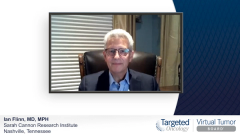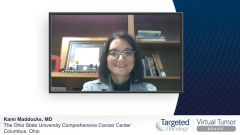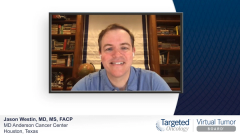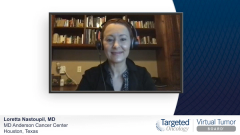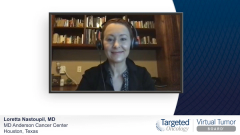
Case 2: Role of L-MIND Regimen as Second-Line Treatment in Transplant Ineligible DLBCL
Kami Maddocks, MD: The outcomes are better than you would have expected in this population butalso a select population in some, in regards to some of the inclusion- exclusion criteria. Now that this is an approved regimen, under what circumstances are you likely to use or not use this regimen as second-line therapy, for example, in eligible?
Ian Flinn, MD, MPH: For me it has to do with what the performance status of the patient is, and perhaps how old they are and that’s why they’re not a candidate for second-line therapy. If someone is very frail, you don’t think can take chemoimmunotherapy, such as the BR [bendamustine] polatuzumab [POLA] regimen, then that’s to me the ideal candidate. If a patient has rapidly progressed a disease, who’s very sick, then this would probably not be my first choice. But those patients that, just by age alone or perhaps other organ function are not transplant candidates, but otherwise doing well and have more, less peripheral disease, to me that’s a candidate for this regimen.
Loretta Nastoupil, MD:One of the interesting things that I’m facing right now in my practice is we don’t have the results yet of the randomized studies that took these patients that are primary refractory or progress within 12 months of frontline treatment, CAR [chimeric antigen receptor] T is currently approved in the third line. And so this is the exact patient where I’m sitting really kind of nervous because the L-MIND study [NCT02399085] didn’t address them, but it is probably my preferred approach for a patient in second line that is not a candidate for salvage chemotherapy. I’d like to go to CAR T but I don’t have it available from an insurance approval standpoint.
What we need to do as a community is collect some real-world data and see how this regimen performed in this patient population because it fits very nicely right now in my treatment landscape. Second line patients are not transplant candidates, but I’m also nervous about how well it’s going to perform in a patient that was not included in the trial.
Jason Westin, MD, MS, FACP: I agree. And this population on the study is not super refractory, but it’s not a cherry-pick population in the sense where there aren’t sick people here. A lot of these people were refractory for their most recent therapy, not initially primary refractory. This is perhaps not every patient in the clinic fits in to the eligibility criteria for this study, but it is an ineffective therapy. And as Dr Flinn mentioned, those that get a CR [complete response] have an awesome durability of response. The duration of response is almost CAR T cell-like for these patients. This is a therapy that has a big future. The concern that we’re all dancing around about, if this person were to get this and not respond, could you potentially go to CAR T cell having used a CD19- targeted therapy and another CD19-targeted therapy. We don’t know, but I don’t think there’s a huge risk that you’re going to be CD19 null afterward. Antibodies aren’t for the same selection pressure that CAR T cells are for selecting out CD19 or CD20 or whatever the target is null.
We’ve seen patients with prior Rituxan who are CD20 negative, but you just need a tiny bit of antigen for CAR T cells to work on the cell surface. And you’ll notice in the labels for CAR T cells, there’s no requirement for checking for CD19 expression because it’s there in nearly every patient, at least at some level, and that’s all you need for CAR T cells to work.
Capecitabine, lenalidomide would be an appropriate option to consider for this patient, even if you were potentially considering therapy down the road with CAR T cell.
Kami Maddocks, MD: You guys have highlighted the challenges of a patient who’s refractory to chemotherapy. You know they were excluded from this trial, at least primary refractory, so is there concern using that but at the same time just giving them more chemotherapy is very unlikely to work so maybe this a reasonable choice in that setting. And then also the concerns about targeting CD19. Hopefully we’ll have more data on the antibody, the ADCs [antibody-drug conjugates] that are being developed. Is it really, is CAR T cell a reasonable option after those therapies are used?
Does anybody have any feelings or comment second line versus third line? Is this something that you’d say, “Well, I’d use it but I’d prefer to use something else as a second-line agent versus a third-line agent.” Does this define a difference in this treatment versus our other treatments like selinexor or BR-POLA, CAR T. Do you have to fail a second-line treatment whereas this approval was in the second-line setting. Does anybody have any hesitancy or feelings regarding that?
Loretta Nastoupil, MD:There was a large portion on this study that did include patients at second-line. My general thought is we want to reproduce the great overall survival of PFS [progression-free survival] seen. It’s probably going to perform better in second-line, though I agree with Ian’s comments earlier. If I’m really headed to CAR T, even though we don’t have any proof that you’re going to lose CD19 or have selective pressure for a CD19-negative clone, I probably would reserve it for a third line if I clearly am moving straight to CAR T. But otherwise I think it probably will perform better in second-line.
Kami Maddocks, MD: It’s always a challenge, do you want to save a therapy because it might interfere with CAR T, but you have a patient sitting in front of you and you have to be able to get them into response because CAR T is not going to be an option. It certainly is a challenge and I think you’re right, we need more real-word data on the best way to sequence these or what we can treat, how we can treat patients with these regimens.
I’m looking at the regimen, is there anything that schedule can be intense? Are there pros and cons or barriers that you foresee to patients receiving this treatment?
Ian Flinn, MD, MPH: This might be an ideal patient, it might be an ideal therapy, it’s relatively less intense. This patient’s older, primary refractory disease, and it’s a relatively ideal therapy for this patient.
You know there are pros and cons of any therapy. The cons here are that it’s combined. There are some IB elements of it, and the patient’s constantly coming back into the office for an unedited period of time. I mean the pros are, other than some hematopoietic toxicity, by and large it’s pretty well tolerated. Andit’s almost a kinder or gentler therapy for this older patient, that’s a plus.
Kami Maddocks, MD: In this trial they did treatment until progression, how do people feel about using this maintenance in diffuse large B-cell lymphoma? I mean I think one could argue maybe though CR [complete response] patient didn’t need the maintenance because once they achieved CR they were going to stay in a CR, and those were most of the patients that stayed on. But any comments or feelings from your perspective, or maybe a patient perspective, thinking about that maintenance?
Loretta Nastoupil, MD:I have never been a fan of maintenance in large-cell lymphoma. However, the overall survival is hard to argue. But I 100% agree with you that for those CR patients, it would be interesting to see what a treatment holiday results in. And then if you rechallenge those patients, do they respond. I struggle with it in terms of the duration of treatment, particularly for younger patients who are going to need to resume somewhat of a normal life and get back to a normal work schedule. Every 2 weeks indefinite is challenging.
For our older patients, the alternative may not be great, it’s death, they might be more amenable to that, frequent visits to the office. But the schedule is challenging.
Jason Westin, MD, MS, FACP: I agree with Dr Nastoupil. There’s no historical precedent for maintenance therapy for large-cell. Lenalidomide potentially in this frontline study had some benefit, but it wasn’t inclusive. The challenges here are there’s still disease and we just don’t have the tools yet. As we get circulating tumor DNA assays that are more robust, can measure, does this patient have cancer that you’re suppressing, or potentially could there be a cure? We don’t yet know.
In patients that I’ve had on other therapies which are relatively well tolerated which should go forever that have stopped and had treatment holidays, I’ve had some good success with people staying in remission for a long period of time off of a therapy. And if there’s intolerability or the patient just gets tired of doing it, I don’t think it would be unreasonable to stop. Potentially you could rechallenge the patient if they had a good treatment holiday without relapse, you could go back to the well a second time.
Kami Maddocks, MD: That’s a great point and this may be great for circulating tumor DNA where if there’s no evidence of any disease at all by any measure, then they probably, or maybe are okay to not continue on that where maybe it’s helping a small percentage of patients.
Then would you consider CAR T after tafasitamab? We kind of answered that. I mean there is no great answer for this. There were a couple patients treated on the trial who went on to CAR T but that’s very minimal data, and I think we’ll have more, more information in the future as we use this in the real world on patients to see if this is an effective option.
Transcript edited for clarity.



